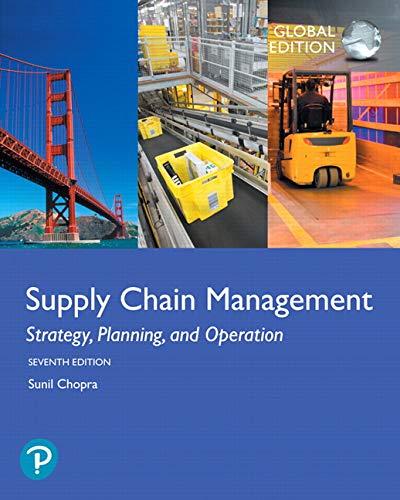Kevin Cho, general manager at Kloss Planters and Harvesters (KPH), left the meeting with his strategic planning
Question:
Kevin Cho, general manager at Kloss Planters and Harvesters (KPH),
left the meeting with his strategic planning team wondering whether it made sense to replace the separate factory for planters and harvesters with a single factory that could assemble both.
A Brief History of Planters and Harvesters
Since humans started farming, they have sought to ease the task of planting and harvesting their crops. In his Naturalis historica, Gaius Plinius (AD 23–79) described a reaping machine that broke off the ears of corn and accumulated them in a box. In 1799, the first verifiable patent for a reaping machine was granted to the English inventor Joseph Boyce. In 1831, Cyrus Hall McCormick introduced the world’s first corn reaper under the name of the “Virginia Reaper.” The Virginia Reaper was powered by a horse. Over time, other companies introduced combine harvesters that were self-propelled and powered by a combustion engine. Harvesters today allow a farmer to harvest large cornfields in the comfort of air-conditioned cabs!
After years of planting corn the way Squanto had taught the settlers, help arrived for American farmers when hand planters were introduced during the late 1800s and early 1900s. Some of these devices allowed farmers to plant two acres per day instead of the single acre possible with hand-planting. Today, planters can seed multiple rows while traveling at 10 miles per hour. The evolution of both planters and harvesters has certainly made the farmer much more effective.
KPH Production Planning
KPH assembled planters in Davenport, Iowa, and harvesters in Ames, Iowa. Demand for each product was highly seasonal, as shown in Table 8-12. Corn was generally planted between March and May and harvested between September and November. As a result, demand for planters peaked in March, whereas demand for harvesters peaked in September. Each factory aimed for a production plan that allowed them to meet annual demand at the lowest possible cost.
 The capacity of each factory was determined by the number of assembly workers available. Each machine (planter or harvester) required 100 labor hours for assembly. Each factory operated for 20 days a month, 8 hours a day. Assembly workers were paid $20/hour during regular time. They could be asked to work up to an additional 20 hours per month as overtime. Overtime was paid at the rate of $30/hour. Given the highly seasonal nature of demand, KPH laid off some workers during the low season and rehired them for the peak. Each layoff cost KPH $5,000 and each rehiring cost $3,000. Each factory generally built inventory in anticipation of the peak. It cost $300 to carry a machine in inventory from one month to the next. KPH could also choose to delay a customer order by stocking out in a given month and filling the stockout from next month’s production. However, each unit delayed in this manner cost $2,000 in discounts offered to customers to keep them happy. The company had a policy of ensuring that there were no stockouts in December so the new year started out without any unfilled orders. The material cost for each machine was $20,000.
The capacity of each factory was determined by the number of assembly workers available. Each machine (planter or harvester) required 100 labor hours for assembly. Each factory operated for 20 days a month, 8 hours a day. Assembly workers were paid $20/hour during regular time. They could be asked to work up to an additional 20 hours per month as overtime. Overtime was paid at the rate of $30/hour. Given the highly seasonal nature of demand, KPH laid off some workers during the low season and rehired them for the peak. Each layoff cost KPH $5,000 and each rehiring cost $3,000. Each factory generally built inventory in anticipation of the peak. It cost $300 to carry a machine in inventory from one month to the next. KPH could also choose to delay a customer order by stocking out in a given month and filling the stockout from next month’s production. However, each unit delayed in this manner cost $2,000 in discounts offered to customers to keep them happy. The company had a policy of ensuring that there were no stockouts in December so the new year started out without any unfilled orders. The material cost for each machine was $20,000.
The planter factory ended December with 244 workers and 250 planters in inventory. The harvester factory ended December with 100 workers and 50 machines in inventory. The production plan at each factory attempted to meet demand in Table 8-12 at the lowest possible cost while ensuring that the factory ended December of the coming year with the same labor and inventory as the previous December.

Options for New Factories Given the age of the current factories, Kevin planned to replace them with new factories. One option was to replace each factory with a similar new factory. The other option was to expand the Davenport factory to allow for both planter and harvester assembly. The investment for the two options was going to be very similar. Thus, Kevin requested his strategic planning team to identify any advantages of a single factory.
The team pointed out that countercyclical nature of demand for planters and harvesters canceled their individual seasonality of demand to some extent. Common assembly steps for the two products would allow KPH to use the same labor for the two products. This had the potential to significantly reduce the number of employees laid off and rehired each year. Besides improving employee morale, such a change had the possibility of reducing costs. Kevin asked the team to quantify any cost-related and employee-related advantages offered by the single factory. He would base his decision on these numbers.
Step by Step Answer:

Supply Chain Management Strategy Planning And Operation
ISBN: 9781292257891
7th Global Edition
Authors: Sunil Chopra





